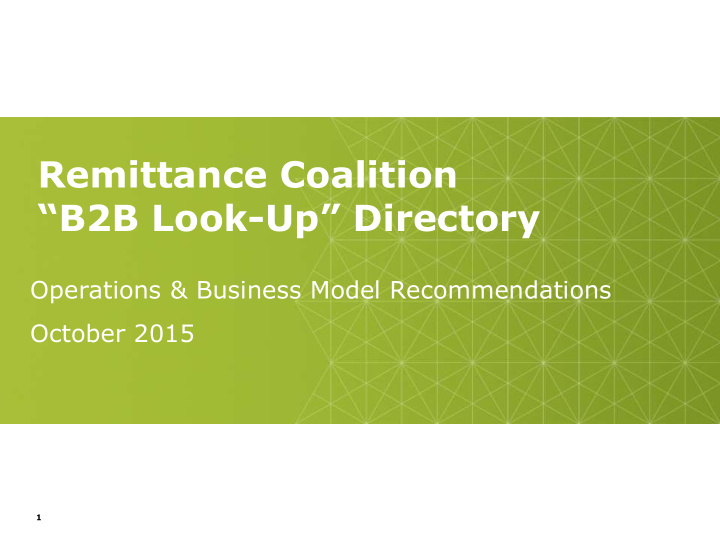



Remittance Coalition “B2B Look - Up” Directory Operations & Business Model Recommendations October 2015 1
Core Assumptions Volunteer-driven Remittance Coalition project Modeled as an open, non-proprietary nonprofit industry utility The Directory is not a payment system The Directory does not store sensitive payment & transaction information; it provides access to payee information only The Directory is set up as a federated model that provides access to other Directories via nodes & hosts Recommendations & issues for consideration, which a future Directory organization will need to operationalize, have been developed Recommendations include: security & other innovations developed by Federal Reserve Security & Faster Payments Task Forces be incorporated into the Directory service 2
“B2B Look - up, Inc.” Draft Charter B2B Look-up (this name is a placeholder – not a proposal or final name) will be organized in a manner that enables the provision of directory and educational services that is effective, efficient and secure to businesses, financial institutions (FIs) and other service providers. B2B Look- up’s services will likely include enrollment, validation and access to payee information required to exchange B2B payments between corporate suppliers (payees) and buyers (payers). B2B Look-up will also likely provide a process for assuring that each node follows a set of rules for the inclusion of any data and develop policies to ensure that corporate payees have been appropriately enrolled and validated. B2B Look-up will enable access to and cache relevant data to connect payers and payees, but will not store and retain data about payees and payers longer-term. B2B Look- up’s services will be information only and will not include clearing and settling of payments. B2B Look-up may also aim to provide research and education on B2B payments and remittance information, provided adequate staffing and resources are in place to do so. B2B Look-up will offer broad access to its services and will promote open, non- proprietary technology, systems and standards. 3
Driving directory critical mass Two-sided market Payee focused: Build it, & they will come – the “Field of Dreams” approach – Evangelize directory benefits to payee – Drive self-enrollment of payees – Existence of payee critical mass drives payer usage of directory Payer focused: “Islands of Automation” approach – Payers influence their payees (vendors/trade partners) to enroll into directory – Payers & their payees represent an “island of automation” – Each payer served by a node-operator Both approaches can co-exist – An FI can be a node operator serving its payee account holders – A Payment Service Provider can be a node operator serving a payer & its payees – Enrollment Companies can enroll payees directly 4
B2B Directory: Actors and their Roles: Central Directory Enrollment & Validation Search Query Payee#1 Bank Node Payer#1 Node Payer# 1 Service Provider Directory Association Payer#2 Central Access Switch Payer#3 Payee#2 Enrollment Node Company 5
B2B Directory: Actors and their Roles: Payees & Enrollment Enrollment & Validation Search Query Payee#1 Bank Node Payer#1 Node Payer# 1 Service Provider Directory Association Payer#2 Central Access Switch Payer#3 Payee#2 Enrollment Node Company 6
B2B Directory: Actors and their Roles: Payees & Enrollment 7
B2B Directory: Actors and their Roles: Payers 8
Operating Rule Categories: Roles & Responsibilities Payee Enrollment & Validation – Payees enroll directly through Node-operator – Payers may wish to invite their suppliers; select an enrollment service provider – Electronic Payment Identity (EPI) is owned by the Payee Node-Operators – Certified Banks, Service Providers, & Corporate Node-operators ▪ Standards set by Directory Association – Validation ▪ Must meet minimum KYC requirements for all payee enrollments Central Node Operator – Provides query service to/from Payers & Node-operators Payers – Initiate queries to retrieve Payee EPI records – Access security to adopt FRB Faster Payment taskforce recommendations 9
Legal Issues for Consideration Governance / Structure – Profits, loss, tax – Management, employees, overhead (e.g. lawyers) – How supervised? Regulatory jurisdiction? Business considerations – How funded? – Intellectual property as income source? Licensing considerations. – Relation to operator(s) – governed by service agreement(s)? Rulemaking – How to bind: ▪ Operators ▪ End Users – Relation to existing law Liability – IP – patent “trolls” and legitimate patent holders – Operational risks – inaccuracies and breaches 10
Compliance & Operational Issues Potential areas requiring further analysis: – Compliance Risks ▪ KYC - Know Your Customer ▪ GLBA – Gramm Leach Bliley Act ▪ OFAC – Office of Foreign Asset Control ▪ AML - Anti-Money Laundering ▪ PCI – Payment Card Industry Data Security Standard – Operational Risks ▪ Security: Application Code Vulnerability ▪ Security: Hacker Attacks ▪ Security: Identity Theft ▪ Performance: Disaster Recovery ▪ Performance: Service Level Agreements 11
Recommend
More recommend